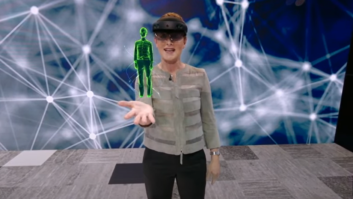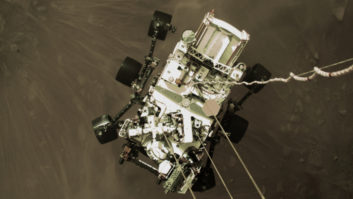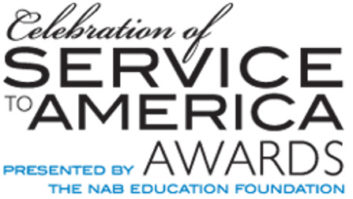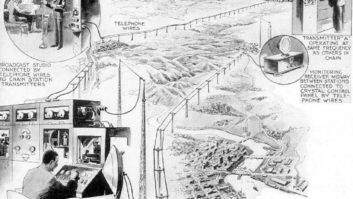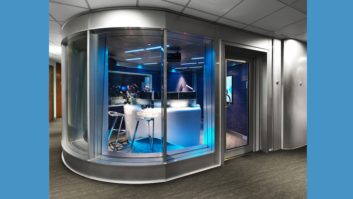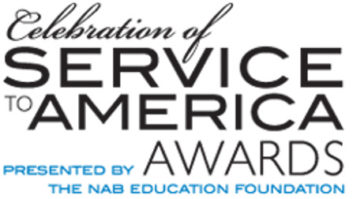Take a moment to find Las Cruces, N.M., and draw a 100-mile circle around the town. Ten decades ago, that area consisted of scattered farms and ranches, small communities. There was no electricity and few self-powered vehicles beyond the horse or mule.

New Mexico State University in its first iteration.
This was the constituency to be served by the New Mexico College of Agriculture and Mechanic Arts. Some called it “The Cow College.” Yet the land grant school’s 1890 charter of education and enrichment was taken seriously. Major courses of study included engineering, biology, chemistry, fine arts, horticulture and, of course, agriculture.
The college was seeking new ways to reach out to their extended community when an electrical engineer named Ralph Goddard joined the faculty.
Goddard was lured to New Mexico with the college’s offer to be head of the electrical engineering department. He found his classrooms populated with eager young students who wanted to learn by doing; And climbing a radio mast was the sort of doing they loved.
With Goddard’s leadership, a small cadre of the best engineering students and area amateur radio operators built the wireless station that would provide the sought-after college-outreach services. The license for KOB was granted April 5, 1922 … a radio station that would be expected to service many scattered thousands in behalf of the college.

The KOB crew in 1923.
GRAB A CUPPA
The new self-funded station had more than its share of start-up issues. It was licensed to the college (and essentially the state); political interference was piled on technology problems. The station dial spot was moved several times. KOB persevered through it all.
Given its early scrappy history, it’s probably not surprising that KOB met various challenges with determination and will. That included the 40-year battle with WJZ/WABC, the Federal Radio Commission, the Federal Communications Commission and the courts over KOB’s service area. If you’re into David and Goliath tales, click on http://www.durenberger.com/documents/KOBWABC.pdf to learn about the machinations and maneuverings of crack legal teams, engaged by owners who always had one more round in them after being repeatedly knocked down.

KOB’s first operating center at the college. This image is from “KOB: Goddard’s Magic Mast: Fifty Years of Pioneer Broadcasting.”
This sort of struggle is fascinating to me as a hardened 60-year radio veteran. It’s one of those stories that’s instructive and almost entertaining — if you’re one of those folks who care about how the radio business developed in the years when the lawyers made much of the money.
There are dozens of similar stories in broadcasting history. Many are anecdotal and even parochial; but some stand out. Probably the most familiar to broadcast historians is that of WLW and its super-powered operation. But did you know there are easily a dozen back-stories of other big stations fighting the clear-channel developments?
Many of these accounts are highlighted in the “Radio” section of my website, www.durenberger.com. This website is an ongoing labor of love.

KOB’s tower.
I was smitten with radio as a 13-year-old. Dad was the athletic director at a small private college in Minnesota and was friends with the sports announcer on the nearby small-town radio station. After enough bugging, Dad took me to the station to meet his sports pal, who was on the air at the time. I’ll never forget walking up the steps into the control room … to find no sports guy … just a reel of tape circling around the reels of an Ampex recorder. Now that was beyond cool!
And those (RCA 76-B) consoles! The engineer on duty opened the production console and demonstrated how it all worked. From that moment and, due to the kindnesses of station folks, I knew exactly what I wanted to do with my life.
Garrison Keillor was correct: “Nothing you do for a youngster will ever be forgotten.”
Of course, I followed the usual path into a paid gig at that station: hanging around and bugging folks. I started working there in 1956 and never looked back. The pay was probably $1.50 an hour.
So radio history remains important to your friendly correspondent. Certainly not all tales have been told; it’d be great to hear how WOI Ames, Iowa, was able to hang on to 640 over all these years. And I’ll be reporting about the “830” battle between WCCO and WNYC. Then there are the stories around the Catalina Island maneuvers.

KOB’s transmitter building.
My plan is to highlight some of the more interesting battles, beginning with the KOB-WABC brouhaha. There’s a good deal of detail here; all of it from official documentation.
So grab a cuppa and navigate to http://durenberger.com/wp-content/uploads/2019/11/KOB-STORY-RADIO-WORLD-OCT-2017.pdf for the KOB/WABC battle.
Mark Durenberger has spent 82 percent of his life in engineering technology, including broadcast, satellite, professional audio, direct broadcast satellite and technical writing, including his work for the early iterations of Radio World. He developed the forerunner of today’s multi-line telephone-studio systems. In 2011 he was inducted as a charter member into the Pavek Museum of Broadcasting Hall of Fame.






